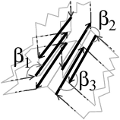|
CGAL 4.4 - Combinatorial Maps
|
|
CGAL 4.4 - Combinatorial Maps
|

CGAL::Combinatorial_map<d,Items,Alloc>CGAL::Dart<d,CMap>CGAL::Cell_attribute<CMap,Info_,Tag,OnMerge,OnSplit>CGAL::Combinatorial_map_min_items<d>CGAL::make_edge<CMap>CGAL::make_combinatorial_polygon<CMap>CGAL::make_combinatorial_tetrahedron<CMap>CGAL::make_combinatorial_hexahedron<CMap>CGAL::is_removable<CMap,i>CGAL::remove_cell<CMap,i>CGAL::is_insertable_cell_1_in_cell_2<CMap>CGAL::is_insertable_cell_2_in_cell_3<CMap,InputIterator>CGAL::insert_cell_0_in_cell_1<CMap>CGAL::insert_cell_0_in_cell_2<CMap>CGAL::insert_cell_1_in_cell_2<CMap>CGAL::insert_dangling_cell_1_in_cell_2<CMap>CGAL::insert_cell_2_in_cell_3<CMap,InputIterator> Modules | |
| Concepts | |
| Classes | |
| Constructions | |
| Basic constructions. | |
| Operations | |
| High-level operations. | |